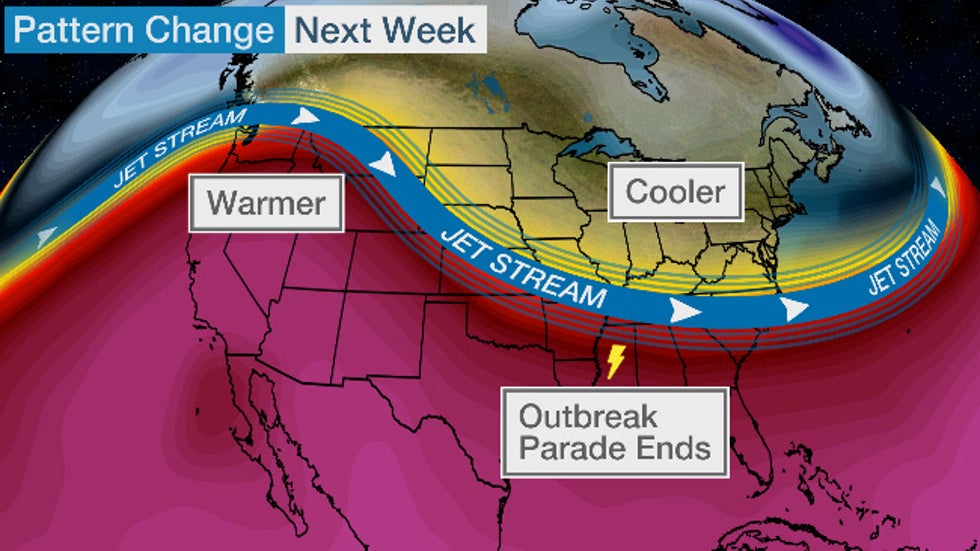Brian Donegan
Published: April 21, 2020
A change in the weather pattern will take shape across the United States by next week, heating up the West, keeping the East cool and putting an end to the recent parade of severe weather outbreaks in the South.
The jet stream will reconfigure itself into a large northward bulge, or ridge of high pressure, over the western U.S., with a broad southward dip, or trough of low pressure, over the eastern states. For most of April, that ridge of high pressure was situated over the Gulf of Alaska, but it will move into the western Lower 48 by next week.
Temperatures tend to warm up when the jet stream bulges northward, so some parts of the West could have their warmest air so far this year. Meanwhile, a southward dip of the jet stream typically causes a drop in temperatures, so it will be rather cool in the East next week.
 Although some scattered thunderstorms remain possible in the South next week, there will be fewer severe thunderstorms overall.
Although some scattered thunderstorms remain possible in the South next week, there will be fewer severe thunderstorms overall.
This pattern change is great news for the South, which has been struck by multiple severe weather outbreaks since Easter and has another round of stormy weather coming this week.
By Sunday, cooler, drier air should push into the South, shutting off the threat of severe weather for a couple of days.
Even with a threat of thunderstorms returning next Tuesday, the setup isn't favorable for tornadoes or an outbreak of severe thunderstorms to the extent we've seen recently.
Temperatures in parts of the Great Lakes and East will be up to 15 degrees below average early next week, as the West warms up to 10 to 15 degrees above average.
 Forecast Highs Compared to Average
Forecast Highs Compared to Average
Warmth is expected to start building in the West as early as late this week. The National Weather Service office in Los Angeles is expecting "a taste of summer with a heat wave" beginning Thursday and lasting through the weekend.
Downtown Los Angeles is predicted to reach 90 degrees for the first time since Nov. 18, with the best chances on Friday and Saturday. This is later than the average date of the first 90-degree day in L.A. of April 15.
Additionally, Phoenix might record its first 90-degree day of the year on Wednesday, more than three weeks later than the average of March 31. By Friday or this weekend, the first 100-degree day of the year is likely. The first 100-degree day has occurred within seven days of the first 90-degree day in Phoenix only four other times on record, according to the NWS.
The latest 6- to 10-day temperature outlook from NOAA's Climate Prediction Center highlights the West, especially areas from California to the Southwest and central and southern Rockies, as having the highest odds of above-average temperatures next week. The Northeast and mid-Atlantic have the highest odds of below-average temperatures.
 Long-Range Temperature Outlook
Long-Range Temperature Outlook
Some longer-range model guidance suggests this warm West, cool East pattern might persist into at least early May.
The Weather Company’s primary journalistic mission is to report on breaking weather news, the environment and the importance of science to our lives. This story does not necessarily represent the position of our parent company, IBM.
The Weather Company’s primary journalistic mission is to report on breaking weather news, the environment and the importance of science to our lives. This story does not necessarily represent the position of our parent company, IBM.

No comments:
Post a Comment